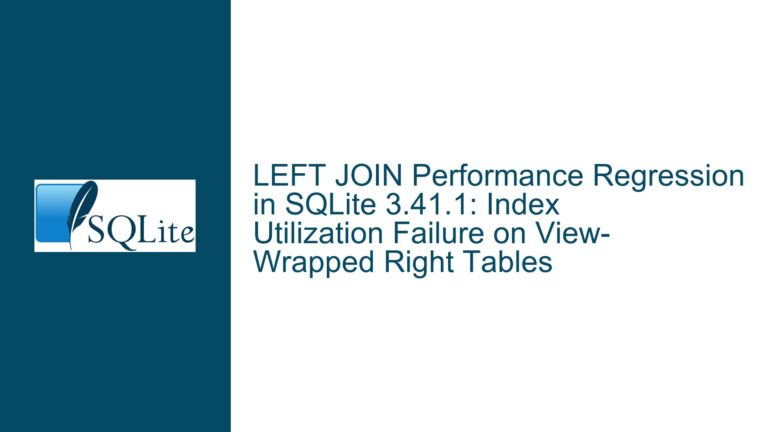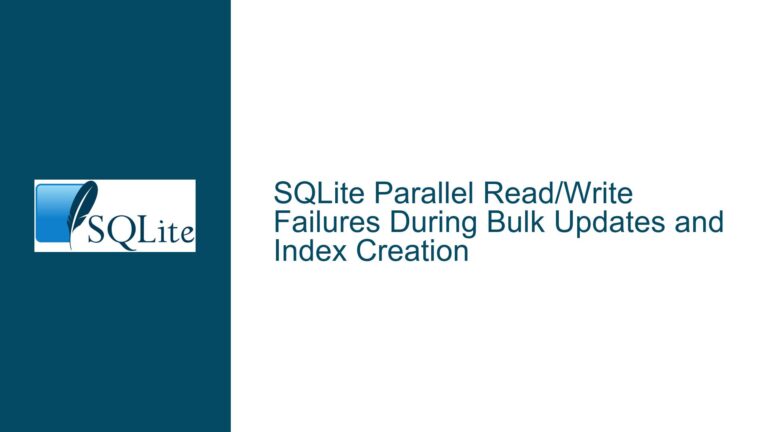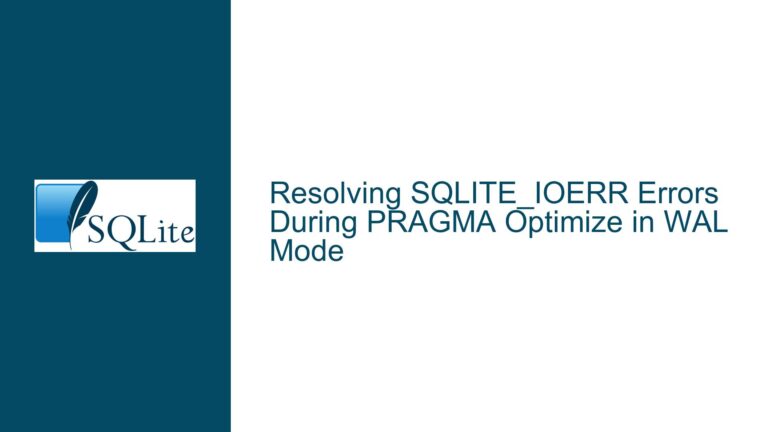Optimizing SQLite Data Migration: Excluding Indexes with VACUUM INTO Alternatives
Understanding the Challenge of Migrating Large Databases Without Index Overhead
Issue Overview
The core challenge revolves around migrating large SQLite databases (e.g., 45 GB) while avoiding the performance penalties and maintenance overhead associated with indexes. The user’s scenario involves merging tables, altering data types, and implementing column compression during migration. Traditional methods like VACUUM INTO are insufficient because they copy indexes by default, which introduces inefficiencies during bulk data transfers—especially on HDDs where random I/O operations (common with index maintenance) severely degrade performance. The goal is to reconstruct the database schema in a new file with tables only, bypassing index creation until after data migration completes.
Key technical constraints include:
- Index Overhead: Indexes require additional disk I/O and memory during insertion, slowing down bulk operations.
- Hardware Limitations: HDDs struggle with concurrent read/write operations for large datasets.
- Schema Modifications: Migrating compressed columns or altered data types may invalidate existing indexes, necessitating their reconstruction post-migration.
- Transaction Management: Large
INSERToperations risk transaction log bloat and memory exhaustion without proper batching.
The absence of a native VACUUM DATA INTO command in SQLite forces developers to devise alternative strategies to replicate tables without indexes. This requires a deep understanding of SQLite’s storage engine, transaction semantics, and optimization techniques for bulk data transfers.
Why VACUUM INTO Fails for Index-Free Migrations and Workarounds
Possible Causes
VACUUM INTO’s Design Limitations:
TheVACUUM INTOcommand rebuilds the entire database, including indexes, by design. It is optimized for defragmentation and storage efficiency, not selective schema migration. This makes it unsuitable for scenarios where indexes must be excluded temporarily.Index Maintenance Costs:
Indexes impose two critical penalties during migration:- Write Amplification: Each row insertion triggers index updates, multiplying disk writes.
- Memory Pressure: Index structures consume memory, exacerbating swap usage on systems with limited RAM.
Lack of Native Schema Filtering:
SQLite provides no built-in mechanism to exclude specific schema objects (e.g., indexes, triggers) during cloning operations. Developers must manually reconstruct the desired schema.Suboptimal Chunking Strategies:
Naive attempts to batch data (e.g., usingWHERE rowid BETWEEN ...) may bypass SQLite’s bulk-insert optimizations, leading to slower performance.
Step-by-Step Solutions for Efficient, Index-Free Data Migration
Troubleshooting Steps, Solutions & Fixes
1. Manual Schema Reconstruction and Data Transfer
Objective: Create a new database with tables only, then populate them using optimized bulk inserts.
Steps:
Attach the Source and Target Databases:
ATTACH 'source.db' AS source; ATTACH 'target.db' AS target;Disable Journaling for Performance:
PRAGMA target.journal_mode = OFF; -- Trade safety for speed; ensure backups existRecreate Tables Without Indexes:
Extract theCREATE TABLEstatements fromsource.sqlite_schema, excluding indexes:SELECT sql FROM source.sqlite_schema WHERE type = 'table' AND name NOT LIKE 'sqlite_%';Execute these statements against the target database.
Bulk Data Insertion with Optimization:
UseINSERT INTO ... SELECT * FROMwith transactions to leverage SQLite’s xfer optimization, which bypasses row decoding/reassembly:BEGIN IMMEDIATE; INSERT INTO target.table1 SELECT * FROM source.table1; COMMIT;- Why This Works: The xfer optimization copies raw database pages, skipping intermediate parsing. This is 10-100x faster than row-by-row insertion.
Chunking to Prevent Memory Exhaustion:
For tables larger than available RAM, split inserts usingROWIDranges. Ensure theWHEREclause uses a clustered key (e.g.,rowidor an integer primary key):INSERT INTO target.large_table SELECT * FROM source.large_table WHERE rowid BETWEEN 1 AND 100000;- Pitfall: Arbitrary
WHEREclauses (e.g., non-indexed columns) disable xfer optimization. Verify withEXPLAIN QUERY PLAN.
- Pitfall: Arbitrary
Post-Migration Index Creation:
Rebuild indexes after data migration to avoid write amplification:CREATE INDEX target.idx_column ON table(column);
2. Optimizing System and SQLite Configuration
PRAGMA Tuning:
temp_store = FILE: Redirect temporary objects to disk, preserving RAM.synchronous = OFF: Disable sync operations during migration (re-enable afterward).cache_size = -N: Limit memory usage to N kibibytes to prevent swapping.
Transaction Management:
- Use
BEGIN IMMEDIATEto acquire a write lock early, avoiding deadlocks. - Commit after each table or chunk to release memory.
Disk I/O Optimization:
- For HDDs, serialize all operations (no parallelism).
- For SSDs, increase
mmap_sizeto leverage fast random access.
3. Automation Scripts for Large-Scale Migrations
Adapt the user-provided script to automate schema extraction and data transfer:
-- MyCustomVac.sql
ATTACH 'original.db' AS source;
.bail on
.output 'schema_and_data.sql'
-- Generate CREATE TABLE statements
SELECT sql || ';' FROM source.sqlite_schema
WHERE type IN ('table', 'view') AND name NOT LIKE 'sqlite_%';
-- Generate INSERT statements with transactions
SELECT
'BEGIN;' ||
'INSERT INTO ' || name || ' SELECT * FROM source.' || name || ';' ||
'COMMIT;'
FROM source.sqlite_schema
WHERE type = 'table';
.read 'schema_and_data.sql'
Usage:
sqlite3 new.db < MyCustomVac.sql
Customization Points:
- Add
PRAGMAdirectives to the generated script. - Exclude specific tables via
WHERE name NOT IN (...).
4. Validating Data Integrity and Performance
Post-Migration Checks:
Row Count Verification:
SELECT COUNT(*) FROM target.table; -- Compare with sourceChecksum Validation:
Usemd5sumon exported CSV data or SQLite’sintegrity_check:PRAGMA target.integrity_check;Index Reconstruction Validation:
Ensure query plans use new indexes viaEXPLAIN QUERY PLAN.
Performance Benchmarks:
- Time data-only migration vs.
VACUUM INTO. - Monitor I/O wait times using
iostat(Linux) or Process Explorer (Windows).
Final Recommendations:
- Always Backup First: Use
.cloneor.backupbefore destructive operations. - Test on Subsets: Migrate 1% of data to estimate runtime and memory needs.
- Leverage SQLite’s Strengths: Combine
ATTACH, xfer optimization, and transaction control for large-scale ETL workflows.
By decoupling schema reconstruction from index maintenance, developers achieve faster migrations, reduced I/O overhead, and predictable memory usage—critical for scaling SQLite databases beyond 50 GB.






